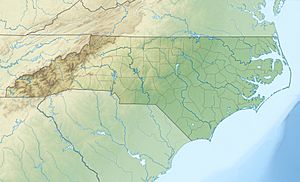Waxhaw Branch facts for kids
Quick facts for kids Waxhaw Branch |
|
|---|---|
|
Location of Waxhaw Branch mouth
|
|
| Other name(s) | Tributary to Lanes Creek |
| Country | United States |
| State | North Carolina |
| County | Union |
| Physical characteristics | |
| Main source | Rays Fork divide about 5 miles southeast of Rock Rest, North Carolina 598 ft (182 m) 34°55′27″N 080°26′58″W / 34.92417°N 80.44944°W |
| River mouth | Lanes Creek about 1.5 miles southeast of Allens Crossroads, North Carolina 448 ft (137 m) 34°53′26″N 080°23′30″W / 34.89056°N 80.39167°W |
| Length | 5.61 mi (9.03 km) |
| Basin features | |
| Progression | generally southeast |
| River system | Pee Dee River |
| Basin size | 6.66 square miles (17.2 km2) |
| Tributaries |
|
| Bridges | Snyder Store Road, Belk Mill Road, Old Pageland Marshvile Road |
Waxhaw Branch is a small stream, about 5.61 mi (9.03 km) long, located in Union County, North Carolina. It's a "tributary," which means it's a smaller stream that flows into a larger one. Waxhaw Branch flows into Lanes Creek. Interestingly, this is the only stream in the entire United States with the name Waxhaw Branch!
Contents
Journey of Waxhaw Branch
Waxhaw Branch begins, or "rises," about 5 miles southeast of a place called Rock Rest, North Carolina. This is where the stream starts its journey.
Flowing to Lanes Creek
From its starting point, Waxhaw Branch generally flows towards the southeast. It makes some curves and turns along the way, like many streams do. Finally, it meets and joins Lanes Creek about 1.5 miles southeast of Allens Crossroads, North Carolina. This is where its waters become part of Lanes Creek.
About the Waxhaw Branch Area
The land area that collects water for Waxhaw Branch is called its "watershed." This watershed covers about 6.66 square miles (17.2 km2) of land.
Water and Forests
The Waxhaw Branch watershed gets a good amount of rain and snow each year, about 48.4 inches. This water helps feed the stream. A large part of this area, about 42%, is covered by forests. These forests are important because they help keep the water clean and provide homes for many animals.



